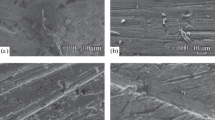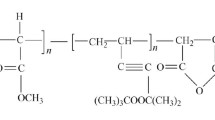Abstract
We investigate the corrosion resistance of amorphous zirconium-based alloys in a simulated biological fluid and in aqueous solutions of hydrochloric acid (with a HCl concentration of 0.1, 0.2, and 0.4 mol/L). Upon studying the effect of a simulated biological fluid, the samples are exposed to the medium in two ways. In the first case, the sample is completely immersed in a corrosive liquid. In the second, the sample is subjected to the local action of a drop of biological fluid deposited onto the surface. It is found that prolonged exposure to the medium leads to dissolution of the surface layer of the sample, while the local impact of drops does not affect the surface. The preliminary implantation of argon and nitrogen ions diminishes the effect of the simulated biological fluid on the samples. Polarization curves are obtained for all investigated alloys. In the curves obtained for alloys in a simulated biological fluid, the cathode and anode branches have a conventional form. The polarization curves for zirconium-based alloys in an aqueous medium with a HCl concentration of 0.1, 0.2, and 0.4 mol/L depend on the elemental composition of the alloys. In a sample without copper, the corrosion potential at different concentrations of HCl changes insignificantly. For a sample with a copper content of 15%, the corrosion potential shifts to the cathode region with an increase in the concentration of hydrochloric acid. The polarization curves of the sample with a high copper content (45%) are qualitatively different from the curves of the other samples. As in the sample with 15% of copper, the corrosion potential shifts to the negative region with an increase in the concentration of hydrochloric acid. The amorphous structure of the electrode material in zirconium-based alloys increases their corrosion resistance in comparison to the crystalline structure since the amorphous structure hinders the transition of the metal to the ionic state.







Similar content being viewed by others
REFERENCES
C. Suryanarayana and A. Inoue, Bulk Metallic Glasses (CRC, Boca Raton, 2017). https://doi.org/10.1201/9781315153483
H. F. Li and Y. F. Zheng, Acta Biomater. 36, 1 (2016). https://doi.org/10.1016/j.actbio.2016.03.047
N. Hua, L. Huang, W. Chen, W. He, and T. Zhang, Mater. Sci. Eng., C 44, 400 (2014). https://doi.org/10.1016/j.msec.2014.08.049
D. Geissler, M. Uhlemann, and A. Gebert, Corros. Sci. 159, 108057 (2019). https://doi.org/10.1016/j.corsci.2019.06.012
P. F. Gostin, D. Eigel, D. Grell, M. Uhlemann, Eb. Kerscher, J. Eckert, and An. Gebert, Metals 5, 1262 (2015). https://doi.org/10.3390/met5031262
D. Grell, Y. Wilkin, P. Gostin, A. Gebert, and E. Kerscher, Front. Mater. 3, 1 (2017). https://doi.org/10.3389/fmats.2016.00060
J. Wataha, P. Lockwood, and A. Schedle, J. Biomed. Mater. Res. 52, 360 (2000). https://doi.org/10.1002/1097-4636(200011)52:2<360::aid-jbm16>3.0.co;2-b
F. Sunderman, Fed. Proc. 37, 40 (1978).
L. Liu, C. Qiu, Q. Chen, and S. Zhang, J. Alloys Compd. 425, 268 (2006). https://doi.org/10.1016/J.JALLCOM.2006.01.048
S. Hiromoto, A. Tsai, M. Sumita, and T. Hanawa, Corros. Sci. 42, 2193 (2000). https://doi.org/10.1016/S0010-938X(00)00056-1
Y. Li, W. Zhang, C. Dong, J. Qiang, M. Fukuhara, A. Makino, and A. Inoue, Mater. Sci. Eng., A 528, 8551 (2011). https://doi.org/10.1016/j.msea.2011.07.077
B. Zberg, P. Uggowitzer, and J. Lofer, Nat. Mater. 8, 887 (2009). https://doi.org/10.1038/nmat2542
V. Raju, U. Kühn, U. Wol, F. Schneider, J. Eckert, R. Reiche, and A. Gebert, Mater. Lett. 57, 173 (2002).
C. Qin, K. Asami, T. Zhang, W. Zhang, and A. Inoue, Mater. Trans. 44, 749 (2003).
S. Pang, T. Zhang, K. Asami, and A. Inoue, J. Mater. Res. 18, 1652 (2003). https://doi.org/10.1557/JMR.2003.0227
T. Inoue, J. Zhang, M. Saida, M. Matsushita, and T. Sakurai, Mater. Trans. JIM 40, 1181 (1999). https://doi.org/10.2320/matertrans1989.40.1181
L. Liu, K. Chan, and G. Pang, Appl. Phys. Lett. 85, 2788 (2004). https://doi.org/10.1063/1.1801677
Y. Liu, Y. -M. Wang, H. -F. Pang, Q. Zhao, and L. Liu, Acta Biomater. 9, 7043 (2013). https://doi.org/10.1016/j.actbio.2013.02.019
H.-H. Huang, H.-M. Huang, M.-C. Lin, W. Zhang, Y.-S. Sun, and W. Kai, J. Alloys Compd. 615, S660 (2014). https://doi.org/10.1016/J.JALLCOM.2014.01.098
H. H. Huang, Y. S. Sun, C. P. Wu, C. F. Liu, P. K. Liaw, and W. Kai, Intermetallics 30, 139 (2012). https://doi.org/10.1016/j.intermet.2012.03.015
L. Liu, Z. Liu, K. Chan, H. Luo, Q. Cai, and S. Zhang, Scr. Mater. 58, 231 (2008). https://doi.org/10.1016/J.SCRIPTAMAT.2007.09.040
Q. Jiang, C. Qin, K. Amiya, S. Nagata, A. Inoue, R. Zheng, G. Cheng, X. Nie, and J. Jiang, Intermetallics 16, 225 (2008). https://doi.org/10.1016/j.intermet.2007.09.009
V. Schroeder and R. Ritchie, Acta Mater. 54, 1785 (2006). https://doi.org/10.1016/j.actamat.2005.12.006
A. Kawashima, H. Kurishita, H. Kimura, and A. Inoue, Mater. Trans. 48, 1969 (2007). https://doi.org/10.2320/matertrans.mrp2007085
A. Kawashima, Y. Yokoyama, and A. Inoue, Corros. Sci. 52, 2950 (2010). https://doi.org/10.1016/j.corsci.2010.05.007
Y. Yokoyama, K. Fujita, A. Yavari, and A. Inoue, Philos. Mag. Lett. 89, 322 (2009). https://doi.org/10.1080/09500830902873575
M. B. Ivanov, E. A. Erubaev, I. N. Kuz’menko, and Yu. R. Kolobov, Nauchn. Vedomosti, Ser.: Mat. Fiz. 26 (33), 152 (2013).
H. H. Uhlig and R. W. Revie, Corrosion and Corrosion Control: An Introduction to Corrosion Science and Engineering (Wiley, Hoboken, 2008).
G. M. Florianovich and E. A. Larchenko, Elektrokhimiya 31, 1227 (1995).
Funding
The work was supported by the Russian Foundation for Basic Research, grant no. 19-42-680001 p_a.
Author information
Authors and Affiliations
Corresponding author
Ethics declarations
The authors declare that they have no conflicts of interest.
Additional information
Translated by O. Zhukova
Rights and permissions
About this article
Cite this article
Yakovlev, A.V., Balybin, D.V., Fedorov, V.A. et al. Investigation of the Corrosion Properties of Bulk Amorphous Metal Alloys Based on Zirconium. J. Surf. Investig. 17, 960–965 (2023). https://doi.org/10.1134/S1027451023050130
Received:
Revised:
Accepted:
Published:
Issue Date:
DOI: https://doi.org/10.1134/S1027451023050130




